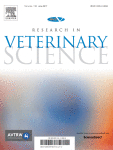Ver ítem
- xmlui.general.dspace_homeCentros Regionales y EEAsCentro Regional Santa FeEEA RafaelaArtículos científicosxmlui.ArtifactBrowser.ItemViewer.trail
- Inicio
- Centros Regionales y EEAs
- Centro Regional Santa Fe
- EEA Rafaela
- Artículos científicos
- Ver ítem
Environment or beekeeping management : What explains better the prevalence of honey bee colonies with high levels of Varroa destructor?
Resumen
Varroa destructor is one of the major threats to honey bee colonies. The mite abundance in the colonies is affected by environmental conditions as well as by beekeeping management. The aim of this study was to recognize the main drivers associated with autumn V. destructor infestation in honey bee colonies when different regions from Argentina are compared. A total of 361 colonies distributed in five Argentinean eco-regions were examined to evaluate
[ver mas...]
Varroa destructor is one of the major threats to honey bee colonies. The mite abundance in the colonies is affected by environmental conditions as well as by beekeeping management. The aim of this study was to recognize the main drivers associated with autumn V. destructor infestation in honey bee colonies when different regions from Argentina are compared. A total of 361 colonies distributed in five Argentinean eco-regions were examined to evaluate Varroa mite infestation rate during autumn and Nosema sp. presence. Regions were different regarding annual temperature, precipitation and especially vegetation landscape. In addition, beekeeping management practices were obtained from a checklist questionnaire answered by the beekeepers. The prevalence of colonies with high infestation level was lower in semi-arid Chaco followed by humid and transition Chaco regions. Also, colonies that were positive for Nosema sp. showed a higher Varroa infestation rate. The “environmental” effect was stronger compared with the influence of secondary drivers associated with beekeeping activities. As well, a significant association between V. destructor infestation rates and Nosema presence was identified. Under contrasting natural conditions, environment seems a predominant driver on Varroa destructor infestation level in honey bee colonies.
[Cerrar]

Fuente
Research in veterinary science 112 : 1-6. (June 2017)
Fecha
2017
ISSN
0034-5288 (Print)
1532-2661 (Online)
1532-2661 (Online)
Formato
pdf
Tipo de documento
artículo
Palabras Claves
Derechos de acceso
Restringido
 Excepto donde se diga explicitamente, este item se publica bajo la siguiente descripción: Creative Commons Attribution-NonCommercial-ShareAlike 2.5 Unported (CC BY-NC-SA 2.5)
Excepto donde se diga explicitamente, este item se publica bajo la siguiente descripción: Creative Commons Attribution-NonCommercial-ShareAlike 2.5 Unported (CC BY-NC-SA 2.5)

